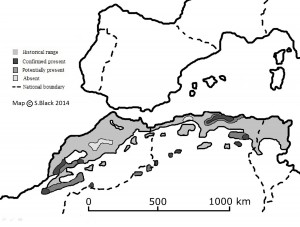This landscape is more reminiscent of Scotland than Africa, but is a valley in north-eastern Algeria. Accounts of lions in this region continued up to the early 20th century (Black et al 2013). One of the more memorable regular encounters by local people with lions used to occur in this region.
The stream above the valley runs near a track which was frequently used by local people taking goods to market.
However the stream, although fairly unassuming (see the photo below) was an importnat water point for lions. This meant that people regularly had to drive lions away from the area with sticks when travelling through the area. A colleague in Algeria has collected verbal accounts from an old man who used to travel this route in the 1920s.
The scene is reminiscent of the encounters in the Gir Forest in Gujarat, India which the local Maldhari people experience with the Asiatic lion (Panthera leo persica).

A Maldhari and his livestock in the Gir forest. He has a stick to steer his animals and to protect them and himself against lions.
Black SA, Fellous A, Yamaguchi N, Roberts DL (2013) Examining the Extinction of the Barbary Lion and Its Implications for Felid Conservation. PLoS ONE 8(4): e60174. doi:10.1371/journal.pone.0060174
Moroccan Royal Lions http://faculty.qu.edu.qa/yamaguchi/Atlas%20lion.htm



